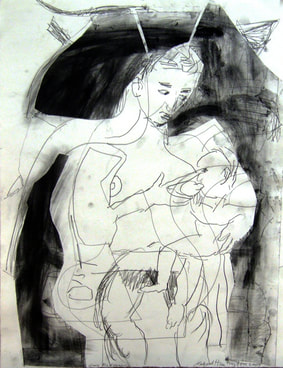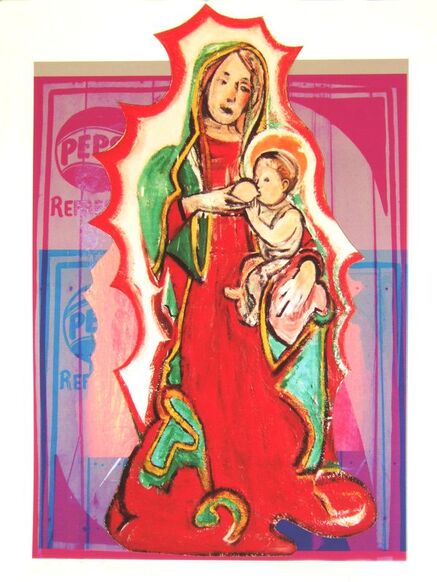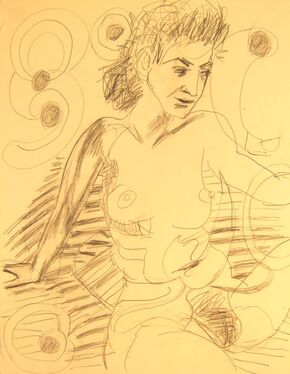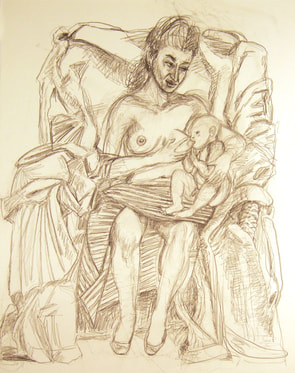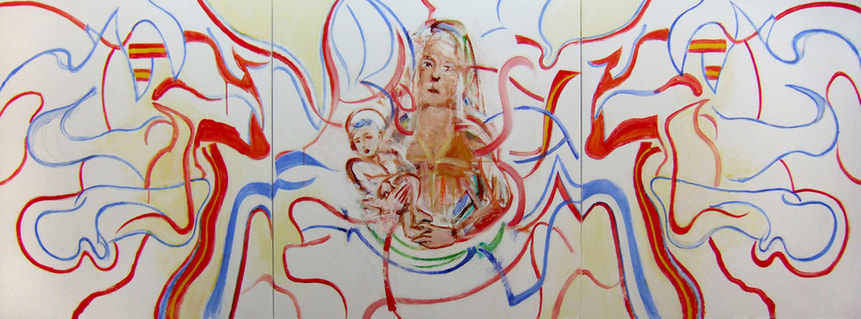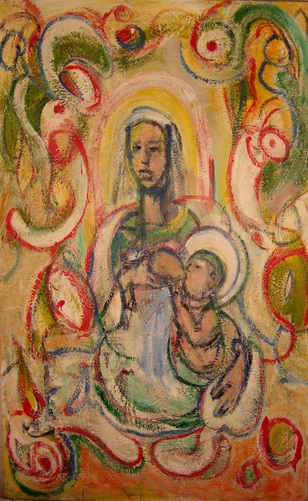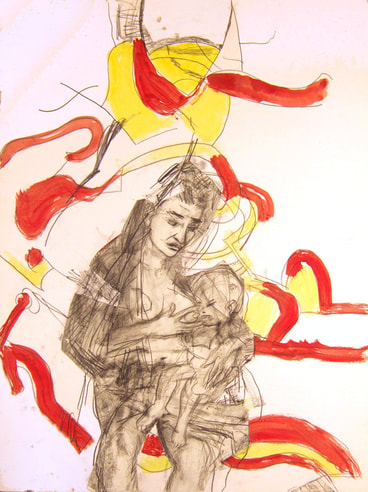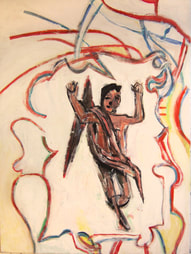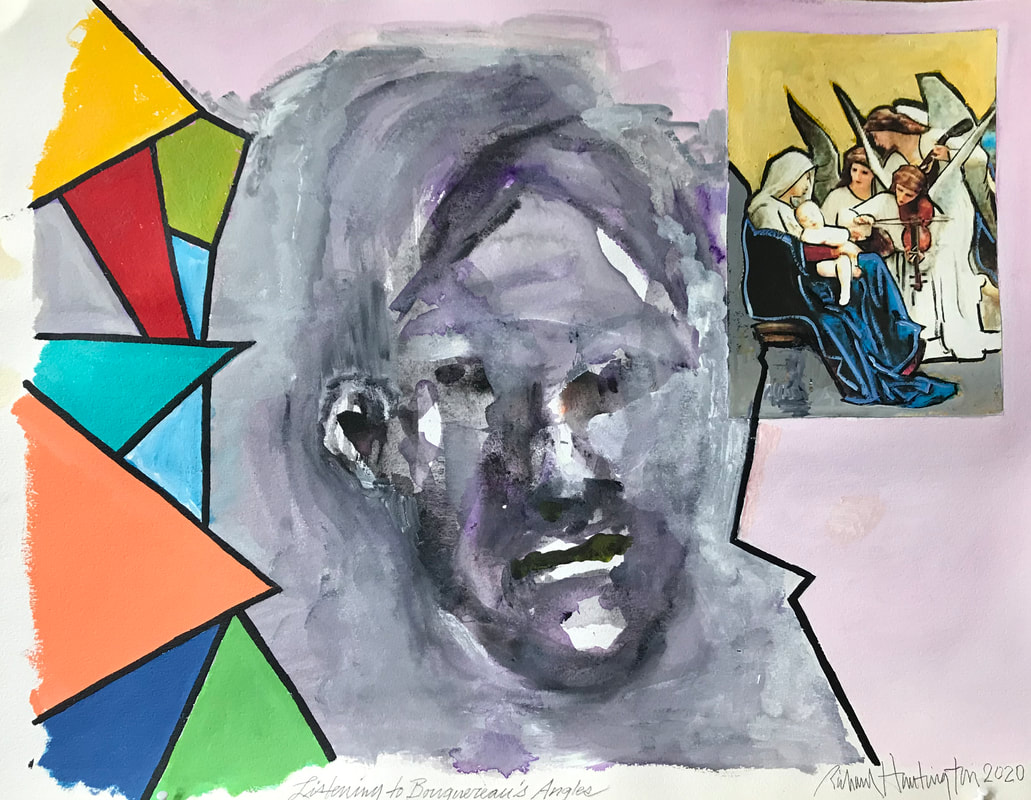MADONNAS & ANGELS
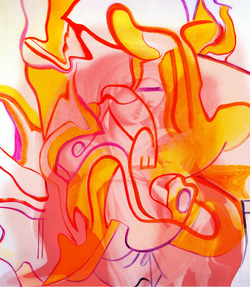
As a practicing atheist (do atheists "practice"?), I never quite intended to take up anything approaching a religious subject matter. But coming upon a gorgeously attenuated Renaissance painting of a Madonna and Child (I unfortunately lost the source, though I've searched high and low through art history books) and seeing wonderful folk treatments of the theme in Mexico, I saw a new potential in the placement of such traditional imagery within a convincing conjunction of subject-matter and the formal arrangement of the composition. I used ribbony forms borrowed from late Willem de Kooning paintings as backdrop in a number of pieces, sometimes implying an abstract, radiating celestial light, as in Our Lady of the Perpetual De Kooning Shapes (see below). In this triptych I placed a painterly version of a Madonna and Child I found on a folk art ceramic plate within an undulating sea of De Kooning shapes that were derived from a single painting presented as a mirror images. The symmetry I thought perpetuated the ancient religious idea of unassailable wholeness, an idea that I took ironically.
On occasion I used Renaissance Madonnas whole and covered them with swirling abstract patterns or deformed their bodies through digital manipulation of one kind or another. Soon enough (too soon for many), the hackneyed notion of the Madonna/Whore seeped into my brain, and I began a series of drawings from a live model who graciously consented to feign the breast feeding of an imaginary Holy Child. Halos, inexplicable light shafts, flowing gowns and other sacred accouterments conflicted with my Madonnas' obvious carnal proclivities, their tendency to let fly their robes in utter disregard of their reputed spiritually pure stature and assume patently immodest poses. Also, they mostly look a little peeved.
The angels that soon followed got similar disrespectful treatment. Often derived from Mexican folk art, they arrived in disjointed and distorted forms, the result of the original artists' disinterest in correct proportions and accurate anatomy. I added to their morphological plight with further deformations and by assaulting them with various, often sharp-edged, abstract shapes. Some, consequently, look quite glum and distressed, as well they might be.
Many of these works are a continuation of my project to place more or less inappropriate ready-made images within broad abstract configurations.
Above: Pink Madonna, archival pigment print, 2011, 16x12
On occasion I used Renaissance Madonnas whole and covered them with swirling abstract patterns or deformed their bodies through digital manipulation of one kind or another. Soon enough (too soon for many), the hackneyed notion of the Madonna/Whore seeped into my brain, and I began a series of drawings from a live model who graciously consented to feign the breast feeding of an imaginary Holy Child. Halos, inexplicable light shafts, flowing gowns and other sacred accouterments conflicted with my Madonnas' obvious carnal proclivities, their tendency to let fly their robes in utter disregard of their reputed spiritually pure stature and assume patently immodest poses. Also, they mostly look a little peeved.
The angels that soon followed got similar disrespectful treatment. Often derived from Mexican folk art, they arrived in disjointed and distorted forms, the result of the original artists' disinterest in correct proportions and accurate anatomy. I added to their morphological plight with further deformations and by assaulting them with various, often sharp-edged, abstract shapes. Some, consequently, look quite glum and distressed, as well they might be.
Many of these works are a continuation of my project to place more or less inappropriate ready-made images within broad abstract configurations.
Above: Pink Madonna, archival pigment print, 2011, 16x12
Prices range widely: the work on paper, from $300 to $600. Major canvases (e.g., Springtime and Our Lady of the perpetual de Kooning Shapes) $4500 t0 $8000
|
Starting upper left above, moving clockwise: Gray Madonna, pencil and graphite on paper, 2010, 16x12; Melanie as Nursing Madonna, pencil, 2010, 16x12; Nude Melanie as Relaxing Madonna, pencil, 2010, 30x22; Melanie with Parted Legs Posing as Nursing Madonna, pencil, 2010, 30x22; and Pepsi Madonna, archival pigment print, 2009, 16x12.
|
Above: Our Lady of the Perpetual De Kooning Shapes, acrylic on three canvases, 2008, 8x3 feet.
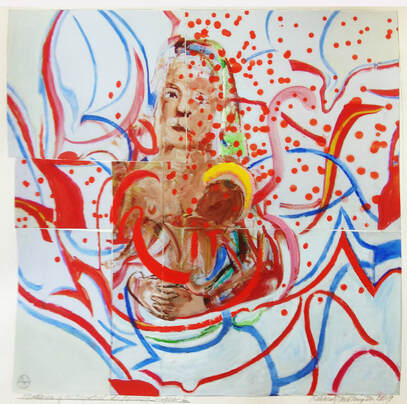
Left: Madonna with de Kooning Shapes 2, collage and acrylic / with archival pigment print, 2019, 21x20
A late variation on Our Lady of the Perpetual De Kooning Shapes.
